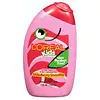What's inside
What's inside
 Key Ingredients
Key Ingredients

 Benefits
Benefits

 Concerns
Concerns

 Ingredients Side-by-side
Ingredients Side-by-side

Water
Skin ConditioningSodium Lauryl Sulfate
CleansingSodium Laureth Sulfate
CleansingCocamidopropyl Betaine
CleansingGlycol Distearate
EmollientSodium Citrate
BufferingCocamide Mea
EmulsifyingSodium Xylenesulfonate
Parfum
MaskingCitric Acid
BufferingSodium Benzoate
MaskingSodium Chloride
MaskingGuar Hydroxypropyltrimonium Chloride
Skin ConditioningGlycerin
HumectantTetrasodium EDTA
Limonene
PerfumingMagnesium Nitrate
Aloe Barbadensis Leaf Juice
Skin ConditioningMacadamia Ternifolia Seed Oil
EmollientCI 19140
Cosmetic ColorantMethylchloroisothiazolinone
PreservativeMagnesium Chloride
CI 17200
Cosmetic ColorantMethylisothiazolinone
PreservativeAscorbic Acid
AntioxidantSodium Sulfite
PreservativePotassium Sorbate
PreservativeWater, Sodium Lauryl Sulfate, Sodium Laureth Sulfate, Cocamidopropyl Betaine, Glycol Distearate, Sodium Citrate, Cocamide Mea, Sodium Xylenesulfonate, Parfum, Citric Acid, Sodium Benzoate, Sodium Chloride, Guar Hydroxypropyltrimonium Chloride, Glycerin, Tetrasodium EDTA, Limonene, Magnesium Nitrate, Aloe Barbadensis Leaf Juice, Macadamia Ternifolia Seed Oil, CI 19140, Methylchloroisothiazolinone, Magnesium Chloride, CI 17200, Methylisothiazolinone, Ascorbic Acid, Sodium Sulfite, Potassium Sorbate
Water
Skin ConditioningSodium Laureth Sulfate
CleansingPEG-200 Hydrogenated Glyceryl Palmate
CleansingDisodium Cocoamphodiacetate
CleansingPEG-30 Glyceryl Cocoate
EmulsifyingGlycol Distearate
EmollientPEG-7 Glyceryl Cocoate
EmulsifyingHexylene Glycol
EmulsifyingCI 17200
Cosmetic ColorantSodium Laureth-8 Sulfate
CleansingSodium Methylparaben
PreservativeDMDM Hydantoin
PreservativeSodium Oleth Sulfate
CleansingMagnesium Laureth-8 Sulfate
CleansingMagnesium Laureth Sulfate
CleansingMagnesium Oleth Sulfate
CleansingPolyquaternium-10
Tartaric Acid
BufferingDisodium Ricinoleamido Mea-Sulfosuccinate
CleansingHea Succinate
Methylparaben
PreservativeParfum
MaskingWater, Sodium Laureth Sulfate, PEG-200 Hydrogenated Glyceryl Palmate, Disodium Cocoamphodiacetate, PEG-30 Glyceryl Cocoate, Glycol Distearate, PEG-7 Glyceryl Cocoate, Hexylene Glycol, CI 17200, Sodium Laureth-8 Sulfate, Sodium Methylparaben, DMDM Hydantoin, Sodium Oleth Sulfate, Magnesium Laureth-8 Sulfate, Magnesium Laureth Sulfate, Magnesium Oleth Sulfate, Polyquaternium-10, Tartaric Acid, Disodium Ricinoleamido Mea-Sulfosuccinate, Hea Succinate, Methylparaben, Parfum
 Reviews
Reviews

Ingredients Explained
These ingredients are found in both products.
Ingredients higher up in an ingredient list are typically present in a larger amount.
Ci 17200 is a synthetic reddish-purple dye.
Glycol Distearate serves as a pearlizing or opacifying agent in cosmetic products.
It's often included in cleansers and haircare products to give them a lustrous or shimmering appearance.
It is derived from stearic acid, a natural fatty acid commonly found in vegetable oils and animal fats.
Glycol Distearate isn't fungal acne safe.
Learn more about Glycol DistearateParfum is a catch-all term for an ingredient or more that is used to give a scent to products.
Also called "fragrance", this ingredient can be a blend of hundreds of chemicals or plant oils. This means every product with "fragrance" or "parfum" in the ingredients list is a different mixture.
For instance, Habanolide is a proprietary trade name for a specific aroma chemical. When used as a fragrance ingredient in cosmetics, most aroma chemicals fall under the broad labeling category of “FRAGRANCE” or “PARFUM” according to EU and US regulations.
The term 'parfum' or 'fragrance' is not regulated in many countries. In many cases, it is up to the brand to define this term.
For instance, many brands choose to label themselves as "fragrance-free" because they are not using synthetic fragrances. However, their products may still contain ingredients such as essential oils that are considered a fragrance by INCI standards.
One example is Calendula flower extract. Calendula is an essential oil that still imparts a scent or 'fragrance'.
Depending on the blend, the ingredients in the mixture can cause allergies and sensitivities on the skin. Some ingredients that are known EU allergens include linalool and citronellol.
Parfum can also be used to mask or cover an unpleasant scent.
The bottom line is: not all fragrances/parfum/ingredients are created equally. If you are worried about fragrances, we recommend taking a closer look at an ingredient. And of course, we always recommend speaking with a professional.
Learn more about ParfumSodium Laureth Sulfate (SLES) is a foaming, cleansing, and emulsifying ingredient. It is created from palm kernel oil or coconut oil. SLES is not the same as sodium lauryl sulfate. It is much milder and less likely to irritate.
SLES helps create foam in personal products. It also prevents ingredients from separating, helping to elongate the shelf life.
Sodium Laureth Sulfate is a type of sulfate. It can be drying. We recommend speaking with a professional about using this ingredient if you have concerns.
Learn more about Sodium Laureth SulfateWater. It's the most common cosmetic ingredient of all. You'll usually see it at the top of ingredient lists, meaning that it makes up the largest part of the product.
So why is it so popular? Water most often acts as a solvent - this means that it helps dissolve other ingredients into the formulation.
You'll also recognize water as that liquid we all need to stay alive. If you see this, drink a glass of water. Stay hydrated!
Learn more about Water